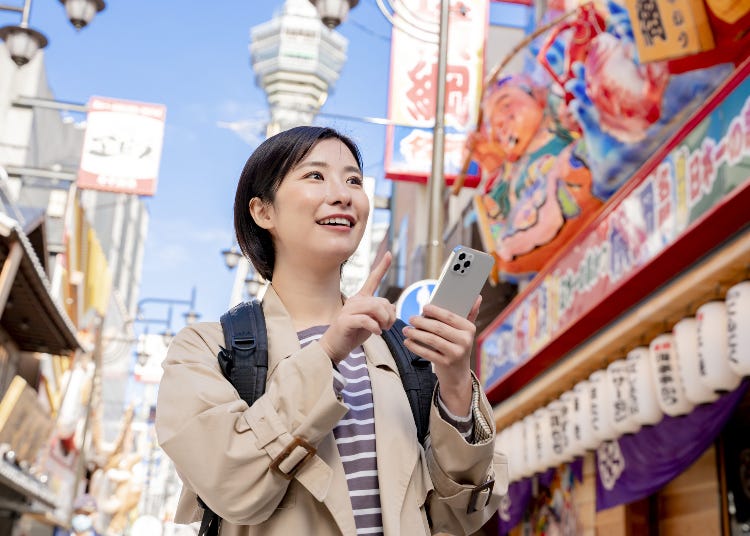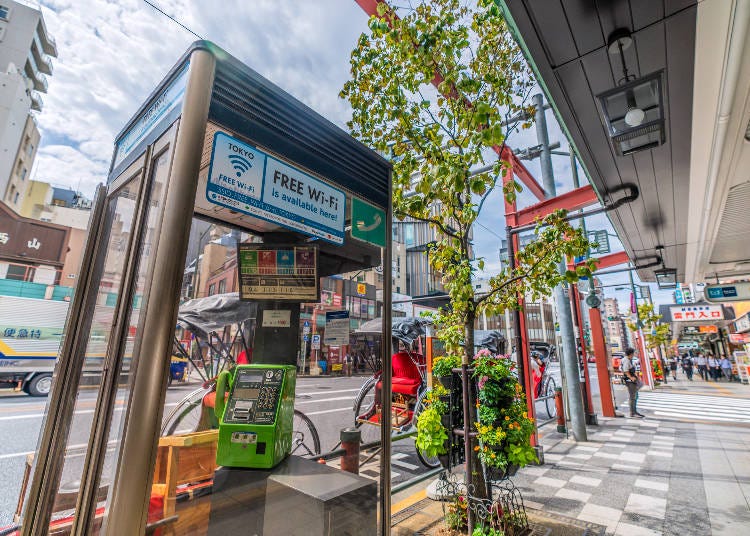
How to Get Internet Access in Japan: 2025 Guide for Tourists and Digital Nomads
- Written by: LIVE JAPAN Editor
Japan’s advanced internet infrastructure makes staying connected as a tourist straightforward, but the variety of options can be overwhelming. Whether you need to navigate cities, book tickets, or share your adventures, this guide outlines the best ways to access the internet in Japan in 2025, tailored to different travel needs.
(Main image: PIXTA)
(This article may contain promotions)
Choosing the Right Option

There are several options to stay connected in all of Japan, ranging from free options like airport and Wi-Fi hotspots, to paid alternatives such as pocket Wi-Fi, internet cafes, eSIMs or prepaid SIM cards. The best option depends on your needs.
- For budget/occasional users
- ・Recommended option: Free Wi-Fi/Paid hotspots
・Why: Low-cost, sufficient for basic tasks in urban areas
- For couples/families with younger children who intend to travel together
- ・Recommended option: Pocket Wi-Fi
・Why: Cost-effective; connects multiple devices; reliable for group travel
- For solo travelers/groups that might travel independently from time to time
- ・Recommended option: SIM/eSIM
・Why: Cost-effective; flexible data plans; easy setup
- For travelers without a compatible smartphone
- ・Recommended option: Rental smartphone
・Why: Hassle-free, includes data and optional voice/SMS
1. Free Public Wi-Fi

There are many free Wi-Fi services all around Japan as long as you know where to go. However, a large majority of these services require the user to either register or download an application in order to use them. Also keep in mind that since this information is shared, the speed may be slow. Keep in mind that public Wi-Fi is often slower and less secure, and may not be suitable for streaming or working remotely. It's best used for short tasks like checking maps or train times.
In order to boost tourism, some areas of Japan even offer their own free Wi-Fi service. These include some of the major areas of Tokyo, Osaka, Kyoto, Fukuoka, and others. However, rural areas may still have limited access.
You can browse a list of places and facilities offering Wi-Fi here.
Tools for Easy Access
The free Japan Wi-Fi Auto-connect app by NTT Broadband Platform automatically connects to over 50,000 free hotspots without individual registrations.
Internet Cafes
If you don't need to access the internet on the go, internet cafes are an option. You should know that internet cafes and comic cafes are usually one in the same, and as such can go by any of several names such as “netto cafe,” or “manga kissa.”
Internet cafes still exist as an option for easy internet access, but are less commonly used in recent years. Instead, they’re often seen as budget-friendly places to rest overnight or relax for a few hours. You may still find them useful for printing or basic internet use, but they’re no longer the go-to solution for tourists looking to get online.
Airport Hotspots
Located in just about all major Airport Terminals in Japan, Free Wi-Fi Spots are available to all travelers. You will have to sign up via the Airport Portal - connecting the device to the Wi-Fi will automatically redirect you. Most airport Wi-Fi services now offer time-unlimited access in multiple languages, and many allow instant connection without needing to register or download an app.
- Narita International Airport (NRT):
- FreeWiFi-NARITA
See details on official website ▶
- Haneda Airport (HND):
- HANEDA-FREE-WIFI
See details on official website ▶
- Kansai International Airport (KIX):
- #AirportFreeWiFi-Kansai, #AirportFreeWiFi-Kansai2.4G
See details on official website ▶
- Chubu Centrair International Airport (NGO):
- FreeWiFi-centrair
See details on official website ▶
- Fukuoka Airport (FUK):
- AirportFreeWiFi-2.4G, AirportFreeWiFi-5.0G
See details on official website ▶
- New Chitose Airport (CTS):
- NewChitose_Airport_Free_Wi-Fi
See details on official website ▶
- Naha Airport (OKA):
- Free_Wi-Fi_NAHA_Airport
See details on official website ▶
Railway Stations
In Tokyo, all Yamanote Line stations, many Shinkansen stations, and other major stations provide access. Similarly, major cities like Osaka, Kyoto, and Nagoya also offer excellent connectivity through key stations that link local, and regional lines.
Free Wi-Fi is available on many Shinkansen (bullet trains), especially on the Tokaido, Sanyo, and Tohoku lines. Long-distance buses and major stations in Tokyo and Osaka also offer free Wi-Fi. These services are convenient for staying connected during travel, although speed and reliability can vary.
- JR East (East Japan Railway Co.):
- JR-EAST FREE Wi-Fi
*Available at many stations and on some trains, requires registration.
See details on official website ▶
- JR West (West Japan Railway Co.)
- JR-WEST Free Wi-Fi
*Available at select stations and on some trains, e.g., Osaka Loop Line.
See details on official website ▶
- JR Central (Central Japan Railway Co.)
- Shinkansen_Free_Wi-Fi, JR-Central_Free
*Shinkansen_Free_Wi-Fi for Shinkansen, JR-Central_Free for stations and some trains.
See details on official website ▶
- JR Kyushu
- JR-KYUSHU FREE Wi-Fi
*Available at major stations and on special express trains.
See details on official website ▶
- JR Hokkaido (Hokkaido Railway Co.)
- JR_Hokkaido_Free_Wi-Fi
*Available on Rapid Airport trains and at select stations.
See details on official website ▶
- Tobu Railway (Tokyo area)
- TOBU Free Wi-Fi
*Available at Tobu stations and on some trains, requires registration.
See details on official website ▶
- Seibu Railway (Tokyo area)
- SEIBU_FREE_Wi-Fi
*Available at select Seibu stations and on Red Arrow limited express.
See details on official website ▶
- Keisei Electric Railway (Tokyo area)
- KEISEI FREE Wi-Fi
*Available on Keisei Skyliner and at select stations, e.g., Narita Airport.
See details on official website ▶
- Tokyo Metro / Toei Subway (Tokyo area)
- Metro_Free_Wi-Fi
*Available at all Tokyo Metro stations, requires registration for up to 3 hours.
See details on official website ▶
- Odakyu Electric Railway (Tokyo area)
- Odakyu_Free_Wi-Fi, ODAKYU HAKONE FREE Wi-Fi (in Hakone)
*Available at select stations in the Hakone area
See details on official website ▶
- Kintetsu Railway (Kansai area)
- Kintetsu_Railway_Free_Wi-Fi, Kintetsu_Railway_Free_Wi-Fi2
*Available at stations and on limited express trains.
See details on official website ▶
- Nankai Electric Railway (Kansai area)
- Osaka_Free_Wi-Fi(OWF)
*Available on limited express trains and at stations.
See details on official website ▶
- Hankyu Railway; Hankyu Railway (Kansai area)
- HANKYU-HANSHIN WELCOME Wi-Fi
*Joint service with Hanshin, available at stations and facilities.
See details on official website ▶
- Keihan Electric Railway (Kansai area)
- KEIHAN FREE Wi-Fi
*Available on select trains (8000 and 3000 series) and stations.
See details on official website ▶
Highway Buses
Many intercity and overnight buses offer free Wi-Fi access while aboard. For details, be sure to check the bus operator’s website when booking.
Hotel Hotspots
Most hotels offer Wi-Fi internet access as well, though some higher-class hotels may have a daily charge, or require a wired LAN connection. Check with the hotel’s website for details.
Public Spaces
Cafes, convenience stores (e.g., 7-Eleven, Lawson), fast food restaurants, and tourist information offices often offer free Wi-Fi.
- Registration: Many networks require sign-up, which can be cumbersome.
- Time Limits: Sessions may be capped (e.g., 60 minutes, up to 5 times daily).
- Speed and Security: Speeds can be slow during peak times, and public networks pose security risks.
- Rural Areas: Coverage is limited outside major cities.
Need Internet for Work or Long-Term Travel?
If you're staying in Japan for an extended period or working remotely, look into monthly rental plans for pocket Wi-Fi, or short-term contracts for home internet. Many co-working spaces in major cities also offer high-speed connections, and an increasing number of accommodations now advertise fiber-optic Wi-Fi as a standard amenity.
2. Pocket Wi-Fi Rentals: Internet on the go

Renting a pocket Wi-Fi device is another option that is very popular when visiting Japan. Many companies provide services that will deliver the device to your hotel, or one can be picked up from the airport. These may be a more convenient choice because you can travel just about anywhere while still having access to the internet. The only drawback is that this service is slightly more expensive and one must be mindful of the battery-life of the device.
Rental prices have dropped in recent years, and pocket Wi-Fi devices now typically start at around 500–1000 yen per day. Some offer unlimited data and 5G support, and you can even find longer-term rental plans if you’re staying for several weeks. Battery life and coverage are generally excellent, especially in cities.
- Pocket Wi-Fi Packages (Airport pickup) (via Klook)
- Pocket Wi-Fi Packages (Airport pickup) (via KKday)
3. SIM Cards and eSIMs

If your device supports eSIM, it’s one of the easiest and fastest ways to get connected in Japan. You can purchase and activate a data plan online before arrival or as soon as you land, without needing to insert a physical SIM card.
Physical prepaid SIM cards are still available at airports, electronics stores, and some convenience stores. You can often order in advance and pick them up at major airports. Plans range from a few days to one month, often with generous data allowances. Make sure your phone is unlocked before you travel.
Some providers offer multilingual support and instructions, making it easy for first-time visitors to set up. Note that SIM cards in Japan are typically data-only, with voice calls not included unless explicitly stated.
Learn more about eSIMs at the article below.
- 4G/5G eSIM Packages (via Klook)
- 4G/5G eSIM Packages (via KKday)
- 4G/5G SIM Card Packages (Airport pickup) (via Klook)
- 4G/5G SIM Card Packages (Airport pickup) (via KKday)
4. Public Wi-Fi Safety Tips
Public Wi-Fi in Japan is generally safe, but it’s still a good idea to take precautions. Avoid accessing sensitive information like banking or email accounts on unsecured networks, and consider using a VPN if you plan to rely on free Wi-Fi regularly.
From free hotspots to high-speed pocket Wi-Fi, Japan has you covered. Make sure to pick the best option for you and focus on enjoying your trip!
The LIVE JAPAN editorial team is a multinational group made up of native editors who have lived in Japan for over five years and Japanese editors who love to travel. Together, we share the best of Japan, offering cultural insights, historical context, event updates, and travel-friendly deals, to support your journey every step of the way.
*Prices and options mentioned are subject to change.
*Unless stated otherwise, all prices include tax.
Popular Tours & Activitiess
Recommended places for you
-

Kambei Sannomiyahonten
Yakiniku
Kobe, Sannomiya, Kitano
-

ISHIDAYA Hanare
Yakiniku
Kobe, Sannomiya, Kitano
-

Kanzenkoshitsuyakinikutabehodai Gyugyu Paradise Sannomiya
Yakiniku
Kobe, Sannomiya, Kitano
-

Jukuseiniku-to Namamottsuarera Nikubaru Italian Nikutaria Sannomiya
Izakaya
Kobe, Sannomiya, Kitano
-
Goods

Yoshida Gennojo-Roho Kyoto Buddhist Altars
Gift Shops
Nijo Castle, Kyoto Imperial Palace
-
Appealing

Rukku and Uohei
Izakaya
Sapporo / Chitose
-

Japan’s Shinkansen Is About to Change Travel in an Unexpected Way
by: Guest Contributor
-

This Winter, Godzilla Takes Over Haneda Airport
by: Guest Contributor
-
Ad

(Opening in Jan 2026) 'THE SUMO LIVE RESTAURANT HIRAKUZA GINZA TOKYO!' 5 Exciting Ways to Experience the World of Sumo!
-

Jujutsu Kaisen Takes Over JR East With a Wrapped Shinkansen This Winter
by: Guest Contributor
-

How to Get Don Quijote's Exclusive 2025-2026 Winter Gift (+Tax-Free Savings)
-
Ad

Preserving the Beauty of World Heritage Site Shirakawa-go for the Future Through Responsible Travel
-

Top 10 Winter Activities in Niseko: Snowmobiling, Horseback Riding, and More
-
Ad

Surprisingly Rich in Silica! Stay Hydrated While in Japan With Bestseller ‘Nomu Silica’
-

8 Unfamiliar (But Totally Normal) Customs in Japan!
-

Visiting Tokyo in September: Best of Autumn in Tokyo
by: Sohail Oz Ali
-

18 Travel Secrets of Aomori Japan: Guide for Sightseeing, Shopping, and More
by: Guest Contributor
-

5 Popular Things to do in Umeda - Osaka's Central Area!
by: WESTPLAN
- #best sushi japan
- #what to do in odaiba
- #what to bring to japan
- #new years in tokyo
- #best ramen japan
- #what to buy in ameyoko
- #japanese nail trends
- #things to do japan
- #onsen tattoo friendly tokyo
- #daiso
- #best coffee japan
- #best japanese soft drinks
- #best yakiniku japan
- #japanese fashion culture
- #japanese convenience store snacks

















